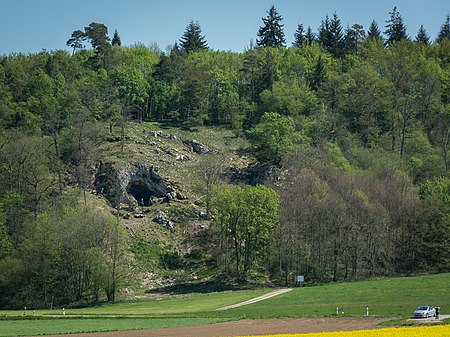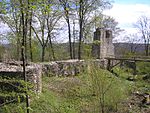Bockstein Cave

The Bockstein Cave, German: Bocksteinhöhle is part of the Bockstein complex – a White Jurassic limestone rock massif. The 15 by 20 m (49 by 66 ft) rock shelter, among small peripheral caves is situated around 12 m (39 ft) above the Lone River valley bottom, north of the towns of Rammingen and Öllingen, Heidenheim district in the central Swabian Jura, southern Germany. Several small openings, that are the actual entrances to the site, lead to various cave sections. The large frontal opening is of modern origin, created during the first excavation works in the late 19th century.Among Mesolithic and Neolithic stone tools and artefacts numerous bone fossils, that date back 50,000 to 70,000 years were found, making the location the oldest known settlement complex of Neanderthals in southern Germany. Moreover, the ca. 8,000 year old and relatively well preserved skeletons of a woman and an infant were discovered. Because of its historical and cultural significance and its testimony to the development of Paleolithic culture, the cave was inscribed on the UNESCO World Heritage List as part of the Caves and Ice Age Art in the Swabian Jura site in 2017.
Excerpt from the Wikipedia article Bockstein Cave (License: CC BY-SA 3.0, Authors, Images).Bockstein Cave
K 3021, GVV Sontheim-Niederstotzingen
Geographical coordinates (GPS) Address Nearby Places Show on map
Geographical coordinates (GPS)
| Latitude | Longitude |
|---|---|
| N 48.579722222222 ° | E 10.2125 ° |
Address
K 3021
89168 GVV Sontheim-Niederstotzingen
Baden-Württemberg, Germany
Open on Google Maps










